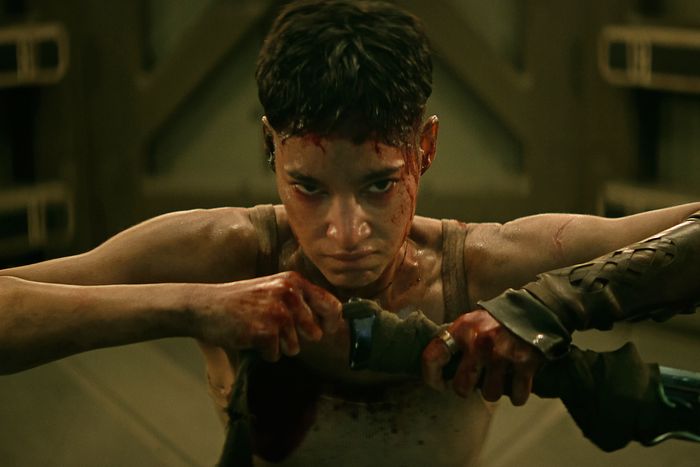
Zack Snyder has wanted to make a version of Seven Samurai since film school. He’s tried to sell his idea to video game companies and to studios, and at one point came close to setting it up as an entry in the Star Wars universe (he’d end up keeping the lightsabers in his story, in the form of glowing red and blue swords). At Netflix, so the upbeat interviews go, Snyder finally got a chance to make the movie he wanted — or rather, a pair of them, since the final project was determined to be too long to be contained in a single chunk. With Part Two: The Scargiver joining December’s Part One: A Child of Fire on the streaming service, Rebel Moon is now available to be viewed in its entirety, and I confess that it made me a little sad in ways that have nothing to do with its bombastic action or body count. Snyder’s career may be defined now by his fan-abetted feud with Warner Bros. over the Snydercut, but creative liberty can be its own burden when your yearslong dreams don’t turn out to be that ambitious.
Don’t get me wrong — The Scargiver is a movie big in scale. It’s arguably not as big as A Child of Fire, which sent former soldier Kora (Sofia Boutella, who deserves better than to be cast as a clenched jawline) bouncing from planet to planet gathering allies to defend the idyllic farming community that took her in from the oppression of the Imperium that she was once part of. But what it loses in location changes, The Scargiver makes up in a final fight that takes place on, under, and above the ground as Kora’s team of outcasts join with the determined locals to take out a dreadnought ship full of soldiers from the Motherworld. It’s a set piece filled with striking images: the mechanical knight Jimmy (voiced by Anthony Hopkins) stands in front of an enemy tank while wearing a crown of antlers; a spaceship falls slowly out of the sky in a rain of flaming debris while two characters look up from the ground; swordswoman Nemesis (Doona Bae) whirls her illuminated blades through the dusty air of a barn backlit by the afternoon sun in the slow motion that remains Snyder’s favorite trick. But these moments, like some of the better ones from the pastoral harvest and the battle preparations that come before, just hang there, with no emotional or narrative momentum to make them anything other than compositions to be briefly admired.
The Scargiver plays like a screensaver. Its shots are littered with lens flares and aesthetically pleasing smoke, with the contrast of golden light and planted fields alongside spacecraft and gas giants on the horizon. It would be just as evocative as a carousel of stills on an unused monitor, or maybe more so, given that the stills wouldn’t be accompanied by ponderous dialogue. (“More than a weapon — it’s what we’re all trying to be,” Kora muses to her lover Gunnar, played by Michiel Huisman.) Rebel Moon is aiming to be a space opera of a grittier, more grounded variety, but what it proves is that Snyder has no actual patience for the character development or world building that makes a fictional universe feel inhabited. As my colleague Bilge pointed out, A Child of Fire is a getting-the-team-together movie in which none of the disparate characters have to actually be convinced to join the team. Instead, at each stop there’s a little mission, after which the target counts as recruited, like a video game. In The Scargiver, the characters sit down at a table with the lets-get-this-out-of-the-way air of parents who have to give “the talk” to their kids, except what they’re sharing are summaries of their dark pasts.
Titus (Djimon Hounsou) is a rebellious Imperium general whose men were executed in front of him despite his attempt to trade his life for their survival. Milius (Elise Duffy) is from a planet whose elders tried to placate the Imperium, only for the place to be wiped out and the survivors sold into forced labor. The hunky Tarak (Staz Nair) is a prince whose parents tried to talk terms with the Imperium, only to, you guessed it, be obliterated. You might be sensing a pattern here, one that stretches back to the first film, when the Imperium forces, led by Ed Skrein as Atticus Noble, murder the leader of Kora’s adopted community and demand all their resources. And yet what does Kora do, at the midpoint of the second film, but try to agree to a deal to surrender in exchange for her friends and colleagues being spared. Does she even go here? Do any of these people? If the first film made it seem like the characters had all been waiting in stasis for Kora and Gunnar to arrive with their offer, the second one makes it evident that Snyder sees their terse backstories not as a way of sketching in his pretty, underdeveloped world, but as a prerequisite before sending the characters off to their possible ends. And at least one has a prolonged, dramatic death that feels like it equals most of their previous screen time. There’s nothing original about Rebel Moon. But in a genre with such well established beats, that at least feels more forgivable than the fact that it also has nothing resembling a pulse.
More Movie Reviews
- The Thriller Drop Is a Perfect Addition to the Bad-First-Date Canon
- The Accountant 2 Can Not Be Taken Seriously
- Another Simple Favor Is So Fun, Until It Gets So Dumb


